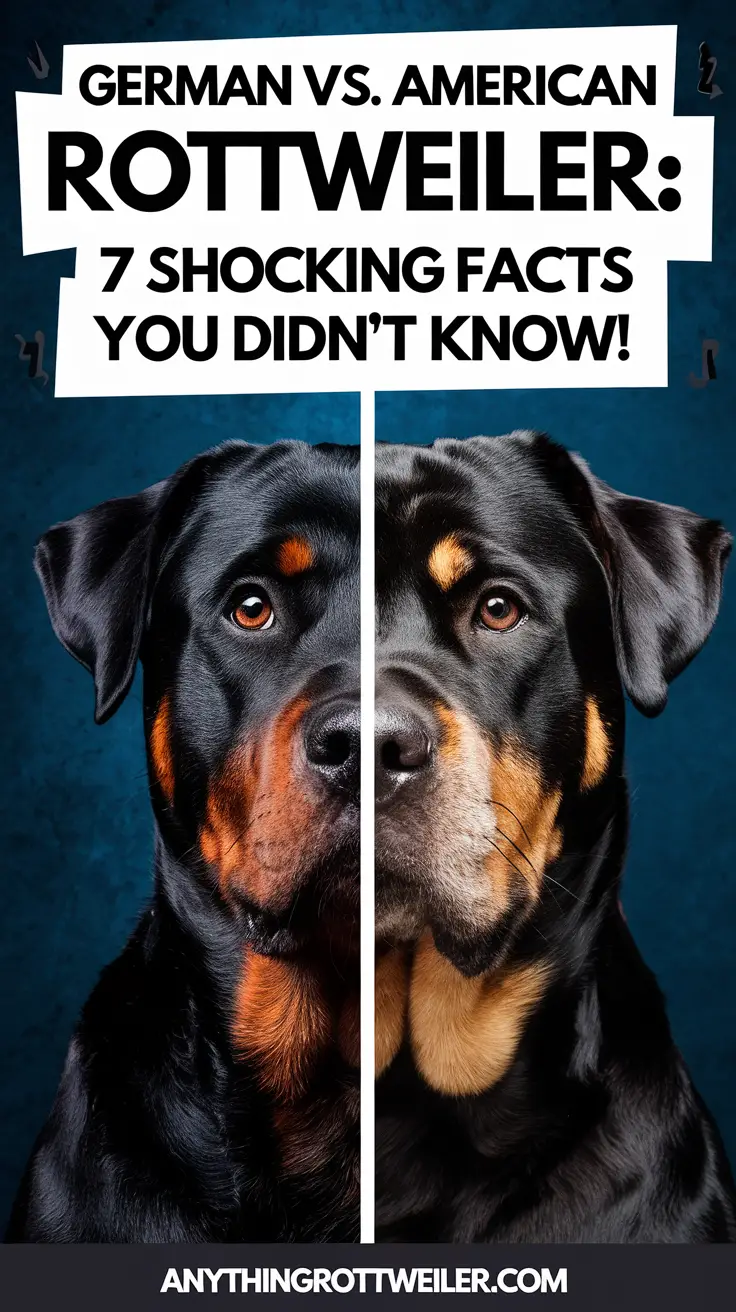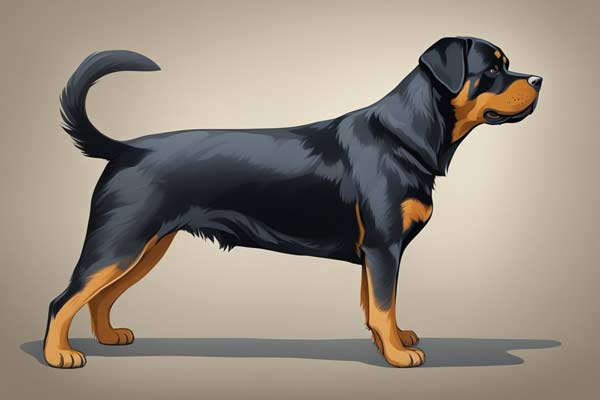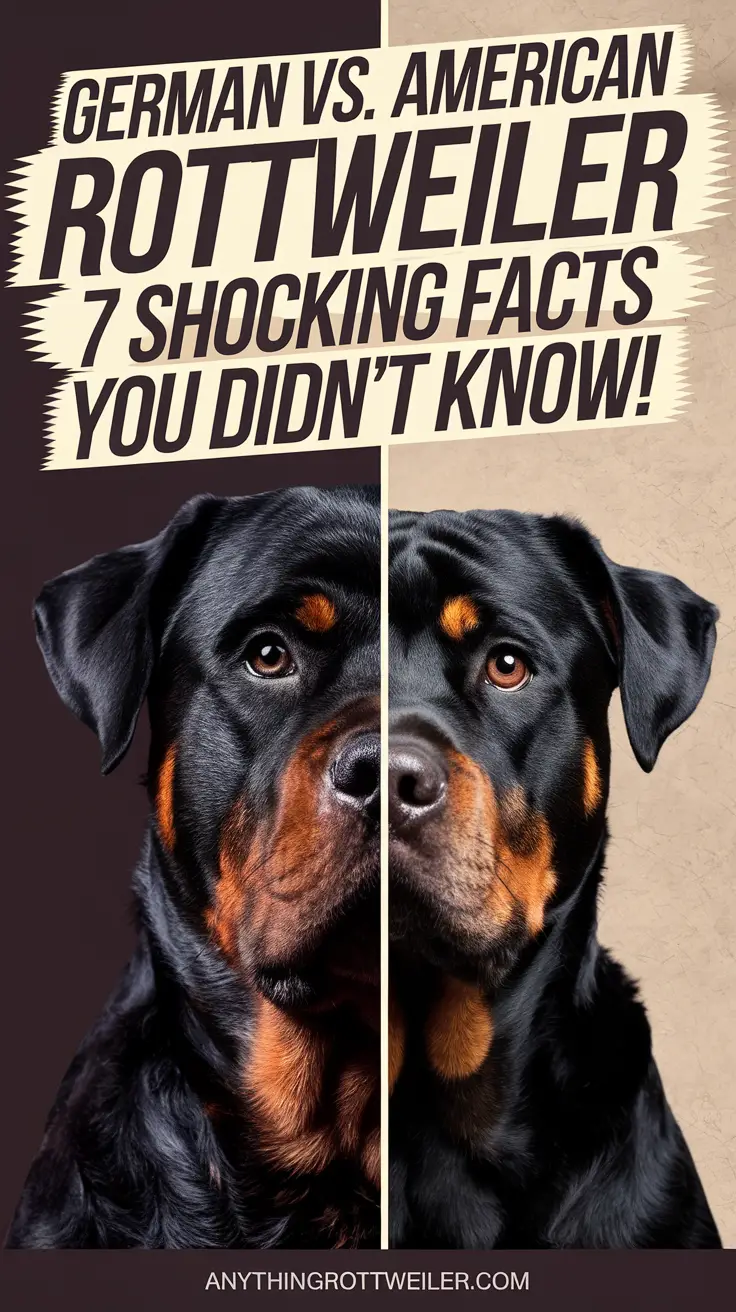German Rottweiler vs American Rottweiler: Which is better? This is a question that many dog lovers have asked. While both breeds share similar characteristics, some key differences set them apart.
This article aims to help you choose between German and American Rottweilers by highlighting their similarities and differences.

The German Rottweiler belongs to a breed of working dogs initially developed for herding and protecting livestock.
They are recognized for their robust, muscular physique, unwavering loyalty, and protective instincts.
On the other hand, the American Rottweiler is a show dog breed developed for its appearance. It is also known for its muscular build but is often more laid-back and friendly than its German counterparts.
In terms of physical appearance, the German Rottweiler is typically more significant and more muscular than the American Rottweiler.
They also have a broader nose and body, and their coat colors are limited to black and mahogany, black and rust, and black and tan.
On the other hand, the American Rottweiler can come in a broader range of colors, including black, tan, and brown.
Origins and History

The Rottweiler breed has a long history that dates back to ancient Rome. The Rottweiler is believed to have descended from drover dogs used by the Roman army to herd and protect cattle.
The breed was further developed in Rottweil, Germany, where the dogs drove cattle to market and pulled carts. The breed was named after the town, and the Rottweiler became known as the “Rottweil butcher’s dog.”
The German Rottweiler is the original Rottweiler breed and is recognized as the purebred standard by the American Kennel Club (AKC). The American Rottweiler is a variation of the German Rottweiler and is recognized as a separate breed by the United Kennel Club (UKC).
The German Rottweiler was first recognized by the AKC in 1931, while the American Rottweiler was not recognized by the UKC until 2001.
Both breeds share a similar history and characteristics, but there are some differences in appearance and temperament.

The German Rottweiler is known for its bigger size and greater weight than the American Rottweiler.
On average, a grown-up male German Rottweiler typically reaches a height of 24 to 27 inches and weighs around 110 pounds.
Meanwhile, the typical female Rottweiler from Germany typically reaches 22 to 25 inches and weighs around 90 pounds.
In comparison, an average male American Rottweiler measures around 25 inches and weighs 95 pounds, while a female measures 23 inches and weighs about 85 pounds.
The German Rottweiler has a broad head and a moderately arched foreheadline when viewed from the side. The eyes are almond-shaped and dark brown.
The American Rottweiler has a smaller head and a flatter foreheadline. The eyes are also almond-shaped and dark brown.
Breed Standards
The German Rottweiler and American Rottweiler have the breed standards that their respective breed clubs set.
The Allgemeiner Deutscher Rottweiler-Klub (ADRK) is responsible for upholding stringent breed standards for the German Rottweiler. At the same time, the American Kennel Club (AKC) serves as the official breed organization for the American Rottweiler.
The German Rottweiler stands out as one of the most ancient dog breeds that continue to thrive today, making it among the earliest purebred breeds.
The ADRK sets very high standards for German Rottweilers, which include physical characteristics, temperament, and health.
The American Rottweiler also has its breed standard set by the AKC. The breed standard of the American Rottweiler is slightly different from the German Rottweiler.
The American breed standard allows for a different appearance, including a broader head and body, compared to the German Rottweiler.
The acceptable coat colors per the ADRK standards for German Rottweilers are black and mahogany, black and rust, and black and tan.
In contrast, the AKC allows for a broader range of coat colors, including black with rust, mahogany, or tan markings.
It’s important to note that both breed standards emphasize the importance of temperament and health.
The breed standards for German and American Rottweilers require these dogs to have a stable and confident temperament.
Additionally, both breed standards require that Rottweilers undergo specific health tests to ensure they are healthy and free of certain genetic conditions.

Physical Characteristics
Regarding physical characteristics, German and American Rottweilers share many similarities but also some notable differences.
Size and Body Structure
German and American Rottweilers are large, muscular dogs with broad heads, muscular necks, deep chests, and thick, strong legs.
However, German Rottweilers are slightly taller and heavier than their American counterparts. German male Rottweilers can grow as tall as 27 inches and weigh between 95 to 135 pounds.
In contrast, American male Rottweilers generally stand at heights of 24 to 27 inches and typically weigh between 80 to 120 pounds.
Coat and Markings
German and American Rottweilers have short, dense coats that are typically black with tan markings. However, there are some differences in the specific coat colors and markings.
German Rottweilers tend to have more defined and darker tan markings, while American Rottweilers may have lighter or less distinct tan markings.
Head Features
The head of a Rottweiler is an essential aspect of their appearance. German and American Rottweilers have broad, powerful heads, almond-shaped eyes, and triangular ears that fold forward.
However, there are some differences in the shape of the head and nose. German Rottweilers typically have a broader, more square-shaped head with a shorter snout, while American Rottweilers may have a longer, more tapered head shape.
Temperament and Personality
Regarding temperament and personality, the German and American Rottweiler have similar traits. They are both known for being intelligent, calm, loyal, and protective. However, some differences set them apart.
The German Rottweiler tends to be more stubborn and powerful than the American Rottweiler. They are also more aloof and confident, which can sometimes come off as aggressive if not properly trained and socialized.
However, with the proper guidance and social interaction, these dogs can develop a loving and affectionate bond with their family.
On the other hand, the American Rottweiler is known for being more affectionate and loving towards their family.
They are also known for being more friendly and outgoing than the German Rottweiler, making them great family pets. However, their robust and protective nature endures, and they can be taught to excel as guard dogs.

Health Concerns
German and American Rottweilers are usually robust dogs, but like any breed, they can face specific health problems. Understanding these potential health issues and proactively maintaining your dog’s well-being is crucial.
Elbow dysplasia is a prevalent health problem found in Rottweilers. It’s a genetic issue that impacts the elbow joint, potentially leading to discomfort and difficulty in movement.
Routine visits to the vet, along with X-rays, can assist in the early identification of this condition. Treatment possibilities often involve the use of medications or surgical procedures.
Rottweilers often face a common health problem called hip dysplasia. This genetic issue causes pain and makes it hard for them to walk properly because it affects their hip joints. Regular vet visits and X-rays can help spot this problem early, and treatment could include medicine or surgery.
Rottweilers also face the risk of cancer, particularly bone cancer, which is the most prevalent form in this breed. Consistent veterinary examinations and catching it early can improve the likelihood of effective treatment.
Aortic stenosis, a heart problem that can impact Rottweilers, may lead to fainting, low energy, and breathing issues. Consistent visits to the veterinarian and identifying the condition early can be helpful in its management.
Finding a reputable breeder who conducts health checks on their dogs is essential to lower the chances of inheriting genetic health problems.
Routine visits to the veterinarian and proactive steps like providing a balanced diet and regular exercise can also contribute to the well-being and happiness of your Rottweiler.
Training and Socialization
Both German and American Rottweilers are highly trainable and intelligent dogs. However, they may require different approaches to training and socialization.
German Rottweilers are known for their strong work ethic and are often used as working dogs in law enforcement, search and rescue, and as guide dogs for blind people. They can be easily trained and perform exceptionally well in obedience contests.
German Rottweilers benefit from early socialization and obedience training to help them develop good manners and prevent aggressive tendencies.
On the other hand, American Rottweilers are often bred as family dogs and companions. They are also highly trainable and make excellent pets but may require less rigorous training than their German counterparts.
Socialization is still essential for American Rottweilers to prevent any behavioral issues.
Regardless of their purpose, German and American Rottweilers require consistent training and socialization to become well-behaved and obedient companions. Using rewards and praise is an effective way to train dogs of all breeds.
Breed Suitability and Ownership
When it comes to owning a Rottweiler, it is essential to consider a few factors to ensure that the breed is suitable for your lifestyle and needs.
Firstly, it’s essential to understand that German and American Rottweilers are big, strong dogs demanding substantial exercise and training.
They may not be suitable for people new to dog ownership or those with limited time and energy to dedicate to their care.
Regarding breed suitability tests, German and American Rottweilers have excelled in obedience, agility, and protection work.
However, it is essential to note that individual personalities and temperaments can vary between dogs, so it is always recommended to meet the specific dog before deciding.
In terms of cost, Rottweiler puppies can be expensive to purchase from reputable breeders.
Additionally, Rottweilers are susceptible to particular health problems, like hip dysplasia and bloat, which can be expensive to address. Prospective owners should consider these expenses when considering getting a Rottweiler.
German and American Rottweilers can make great family pets if socialized and trained correctly, especially when living with kids and people you may not know well.
But since these dogs are pretty big and strong, it’s essential to keep a close eye on how they interact with children and teach children how to behave around dogs correctly.
Breeders and Reproduction
Regarding breeders and reproduction, German and American Rottweilers are bred to meet the breed standards and produce healthy puppies. However, there are some differences in breeding practices between the two.
German Rottweilers are bred in Germany, and breeders must adhere to strict breeding regulations set by the country’s official breed standards.
These regulations include mandatory health testing for breeding dogs and strict temperament and physical characteristics guidelines.
German breeders also prioritize preserving the breed’s working abilities, so they often breed for traits like endurance, strength, and intelligence.
On the other hand, American Rottweilers are bred in the United States, where there are no official breed standards or mandatory health testing requirements for breeders.
Breeding practices vary widely; not all American Rottweilers may be bred for health, temperament, or working abilities. However, many reputable American Rottweiler breeders still prioritize these factors in their breeding programs.
When it comes to reproduction, both German and American Rottweilers can have litters of varying sizes. However, German Rottweilers tend to have slightly larger litters on average.
German breeders also tend to have longer waiting lists for their puppies, as their breeding programs are often more selective and focused on producing high-quality dogs.

